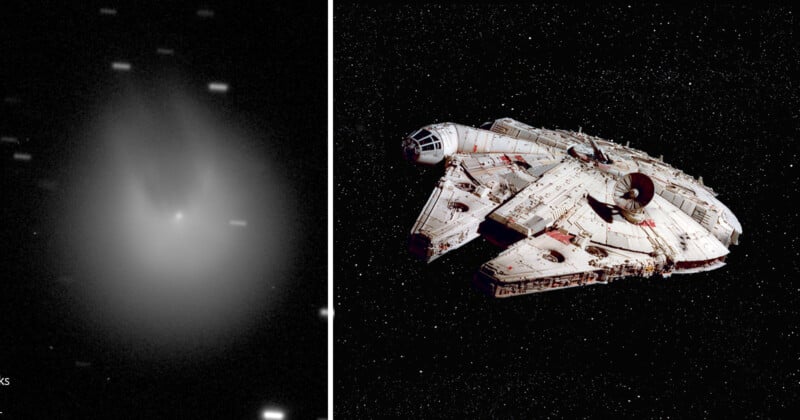Comet Shaped Like the Millennium Falcon Captured in the Night Sky

A comet in the night sky has unexpectedly brightened 100-fold and grown swept-back horns so it resembles the Millennium Falcon — the fictional starship from the Star Wars movies.
The Comet Chasers captured an image of the Millennium Falcon comet just yesterday. Otherwise known as Comet 12P/Pons-Brooks, astronomers were amazed after it abruptly brightened on July 20 and double plumes of debris streamed out the comet’s core giving it the shape of the fastest hunk of junk in the galaxy.
The Comet Chasers are a team of researchers led by Helen Usher of Cardiff University in Wales, U.K. They are using the global Las Cumbres Observatory network to track the unusual comet.
SpaceWeather reports that the comet is now shining with the same brightness as an 11th-magnitude star making it an easy target for backyard telescopes.
![]()
The comet was already on astronomers’ radars because in April, May, and June 2024 it is due to appear bright in the night sky as it passes close to the Sun which it orbits every 71 years. It is predicted to become a bright object and visible to the naked eye.
The timing of its appearance is significant because it will arrive just in time for the total solar eclipse on April 8, 2024, making it possible that it will be visible during the eclipse.
But nine months out from that and Comet 12P/Pons-Brooks has already brightened drastically and scientists are speculating as to why.
One theory is that the Pons-Brooks comet might have an active ice volcano on it.
According to Richard Miles of the British Astronomical Association, the “magma” is a cold mixture of liquid hydrocarbons and dissolved gasses trapped beneath a waxy surface. The ice volcanoes can explode if exposed to sunlight.
12P/Pons-Brooks 2023 jul. 22 22.22 UT 30x40sec RGB 16"/3.2 QHY600 Michael Jäger G00 pic.twitter.com/2AtL5J5sXt
— Michael Jäger (@Komet123Jager) July 23, 2023
Amateur astronomers are encouraged to monitor the comet which is currently in the constellation of Draco “The Dragon” in the northern sky. Despite its increased brightness, it cannot be seen with the naked eye or binoculars — a six-inch telescope is currently required to gaze upon the celestial object.
The Pons-Brooks comet is referred to as a “Halley-type comet” because its 71-year orbit of the Sun makes it similar to Halley’s comet which takes roughly 75 years to orbit the Sun.
Forbes notes that the comet got its name from Frenchman Jean Louis Pons who first discovered the comet in 1812 and was later confirmed by American William R. Brooks in 1883.
Image credits: Feature image courtesy of Comet Chasers and Lucasfilm.